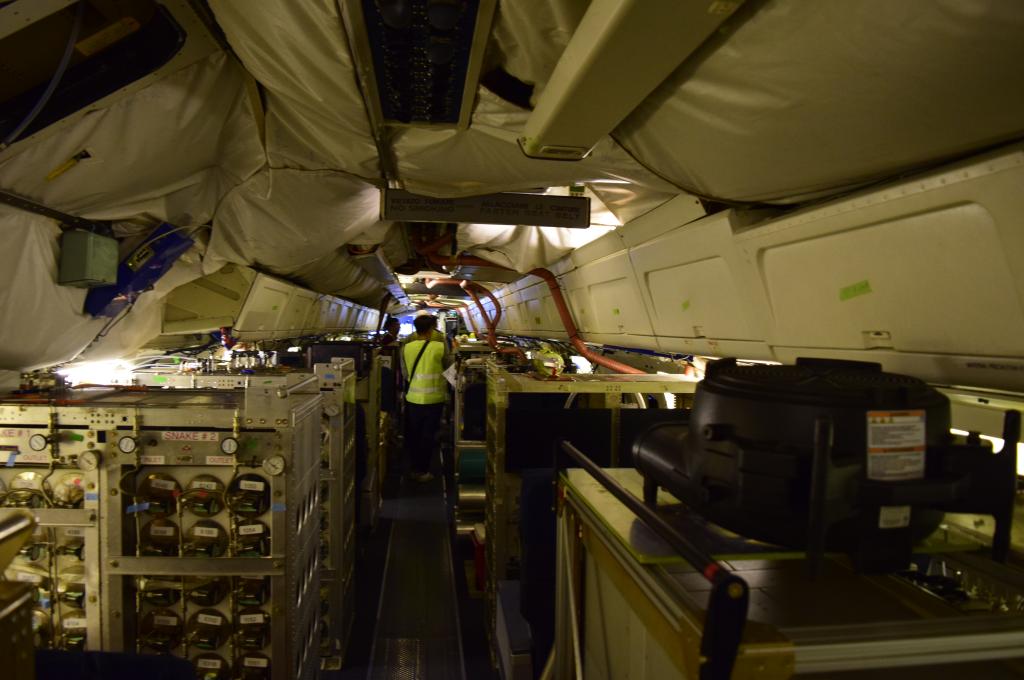SERVIR Southeast Asia Supports NASA Air Quality Project to Better Assess Air Pollution Health Impacts

SERVIR Southeast Asia’s (SERVIR SEA) Air Quality Explorer tool supports researchers in the United States and Thailand to develop a more robust understanding of air pollution and its public health impacts, a topic that –while relatively new—is gaining more importance among policymakers.
The Air Quality Explorer data was utilized in March during a scientific research sponsored by the U.S. National Aeronautics and Space Administration (NASA) when two aircraft packed with more than 40 research and analysis tools collected air samples from different parts of Thailand.
“The planes have tools that are state-of-the-art. It’s one thing to develop these tools for experiments on the ground. It’s something else to actually mount them on aircraft and fly them across the world. They may look very ‘techy’ but they all have humans onboard working with them and even comparing notes and asking questions from teams on the ground when they are flying and collecting data,” said Iowa University Professor Greg Carmichael, the lead scientist on the Airborne and Satellite Investigation of Asian Air Quality (ASIA-AQ) project.
SERVIR SEA is a partnership between U.S. Agency for International Development (USAID), NASA, and the Asian Disaster Preparedness Center. The project integrates publicly-available satellite data and geospatial technologies to help communities across Southeast Asia adapt to regional and transboundary climate issues and mitigate the impacts of climate change.
ASIA-AQ is funded by the Earth Science Project Office (ESPO) at NASA Ames Research Center. SERVIR’s Applied Sciences Team (AST) is part of the ASIA-AQ project.
To choose flight times for the NASA DC-8 and a smaller airplane to fly over Bangkok and crisscross between Bangkok and the northern city of Chiang Mai, the scientific team meticulously evaluated the three-day air quality forecast provided by the SERVIR SEA tool, in conjunction with additional datasets on weather and air quality from other sources during their daily flight planning discussion.
For Thailand, similar to the research that the team conducted in Korea and Philippines, the government gave permission for certain flight days for the research planes.
During those days, the smaller plane with remote sensing equipment flew low over Bangkok but it had to have clear visibility to the lower 3-4 kilometers to collect air samples. The NASA DC-8 airplane included routes to Chiang Mai to collect samples from air pollution caused during the annual agricultural burning season.
Considering that the daily cost of operating those planes runs into hundreds of thousands of dollars, flight planners and the management team relied heavily on SERVIR SEA’s Air Quality Explorer to choose its flight days and times to ensure appropriate climatic conditions for collecting data, and prevented any waste of precious time and money.
“We understand, accept and endorse that Air Quality Explorer is gateway for communications on air pollution data and forecasting in Southeast Asia. So, everything we are doing has in mind to ultimately add to the capability of Air Quality Explorer,” said professor Carmichael.
The SERVIR SEA, NASA, and ASIA-AQ experiment goes beyond collecting air samples and is intended to provide data and analyses that would help Thailand –and other countries in Southeast Asia—develop a better understanding on the impact of air pollution on public health.
During the trip in Thailand, SERVIR SEA’s senior scientist Dr. Dimitris Stratoulias and professor Carmichael gave a presentation to the scientific team on how SERVIR SEA and ASIA-AQ collaboration will advance the Air Quality Explorer tool.
“The updated Air Quality tool will cover the entire Southeast Asia region and provide real-time information from a plethora of new datasets,” said Dr. Stratoulias. “This will include forecasting and real-time data on air pollutants and fire-related information from additional satellite sensors and ground-based observations.”
Most importantly, he said, the upgraded tool will include more health-related indicators for public health monitoring and assessment and will be optimized for speed, visualization and user comfort.
According to the World Health Organization, more than seven million people die globally of air pollution related causes each year. A rising concern also has been the role of tiny air pollutants, known as particular matters or PM –the most serious of which is PM2.5—because the pollutants are invisible to the naked eye.
Annual agricultural burning incidents in Southeast Asia are a major emitting source of PM2.5, thus the interest of the ASIA-AQ experiment to collect more data during the team’s trip to Thailand to fly over Chiang Mai. The city experiences large-scale annual burnings when farmers destroy crops from the previous year to make room for next year’s plantation.
The figure below illustrates the average monthly PM2.5 concentration as reported by the Mekong Air Quality Explorer tool. In March 2024, Chiang Mai held the top rank for PM2.5 levels among the big cities in upper Southeast Asian countries. Furthermore, Chiang Mai consistently ranks among the top 10 most polluted cities in the world (link).

“Right now, (SERVIR SEA Air Quality Explorer tool) is providing three-day forecasts on air pollution and display of the Thailand Pollution Control Department. Our experiments will be able to provide data and information on the fires, where they occur, what and how much pollutants they add. All that is valuable … [for assessing] the health impacts of air pollution in Southeast Asia,” said professor Carmichael.
He added that the ASIA-AQ data will also prove invaluable for developing crop impact models aimed at estimating the loss in crop production within the region in the near future.
Data collected during the two-month Asia experiment –which also involved collecting information on Taiwan when the team was in Korea – is expected to become available to the research and science communities in the next coming months, after which time professor Carmichael expects up to 100 academic and research papers will be drafted.
“Over the next six months, data will be cleaned up and given to everyone and teams will start writing and about a year from now, there will be a science team meeting where Thai scientists and others will share their initial analysis,” he said.
“I really think this is a win-win situation and hope that, in the case of Thailand, this will stimulate interest and funding for the Thai scientists. I also think that the data will be tremendously helpful from the air quality management perspective,” he added.



